Raspberry
Production Information
- Economics and Marketing
- Site Selection
- Planting/Transplanting/Plant Material
- Fertilizer
- Weed Control
- Insects
- Diseases
- Irrigation
- Pruning and Renovation
- Harvesting
- Raspberry Cultivar Trials, 2005 - 2007 (PDF 150 KB)
Description
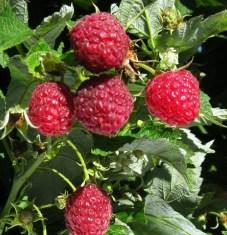
The raspberry (Rubus spp.) is a herbaceous to woody perennial around 1m in height which belongs to the Rose family. Raspberries are closely related to the strawberry. There are two types of raspberries, ones that produce fruit on one year old canes (primocanes - fall bearing) and ones that produce fruit on second year canes (floricanes - summer bearing). The raspberry is an aggregate fruit consisting of a large number of drupelets on a receptacle. When the berry is picked the receptacle is left on the plant. Raspberries are native to North America and can be found across the Prairies.
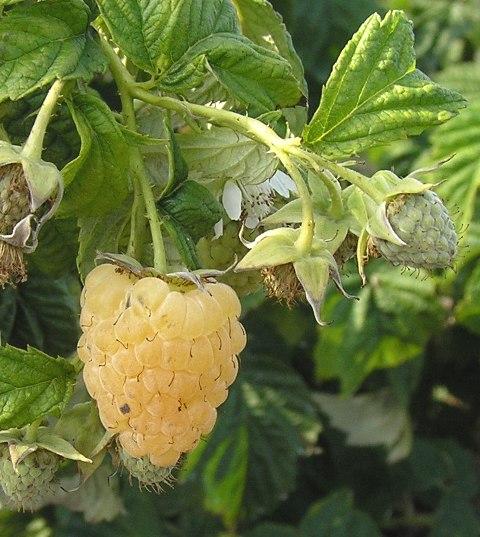
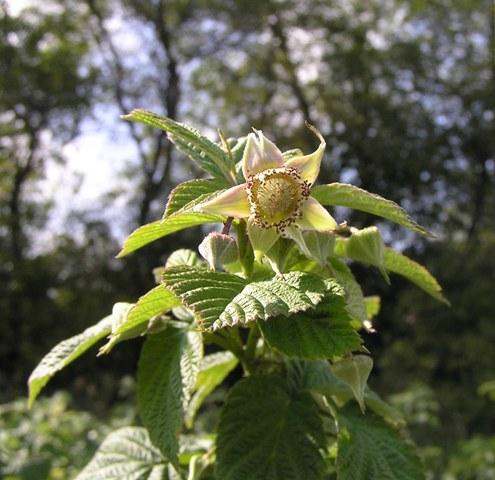
Uses
The raspberry was an important food source for both indigenous peoples and the early pioneers. Raspberries are an important food source for animals during the summer. Raspberries are used fresh, frozen, canned in syrup, jam, juices, and components of baked goods.
Economics and Marketing
Three main methods for marketing raspberries include:
- Pick-Your-Own (PYO)
- Roadside stands
- Wholesale and retail outlets
Raspberries have traditionally been marketed on a Pick-Your-Own (PYO) basis in Manitoba. This has lead to competition for customers. It is estimated that 4 acres of raspberries require 1,400 customer sales, or participation by 20 to 30 percent of all households living within a primary trade area of 10,000 people. To estimate your trade area, enclose an area within a 32 km radius of your farm. Approximately 75% of all customers should live within this area.
Raspberries begin to bear fruit when 2-3 years old and should have a life expectancy of eight full crop years. An annual charge of 1/8 of the establishment cost must be charged to each full production year in order for the establishment costs to be returned. A raspberry planting is capable of producing 2-3 tonnes per acre if maintained and yields as high as 3-4 tonnes per acre have been obtained in experimental plots.
Site Selection
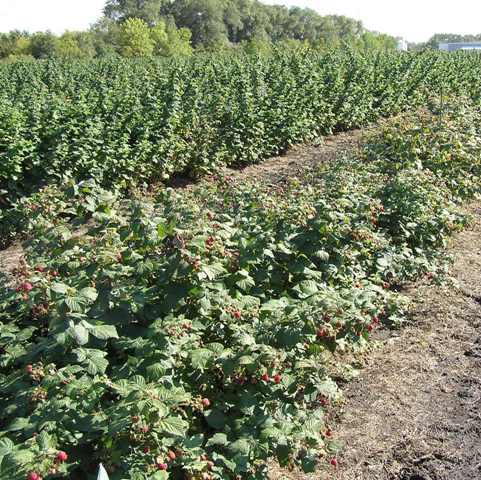
Site selection is an extremely important element in the production of raspberries. Before deciding on a site, growers should consider factors such as soil, water quality, microclimate, shelterbelts, and markets.
The best soil for raspberry production is a deep, friable, well-drained loam, well supplied with humus. Poor growth has been observed on heavy clay or excessively sandy soil.
A good source of quality water for irrigation is essential for frost control and high yielding production.
Land that is slightly sloping is preferred for good runoff and air drainage. A gentle slope to the north or east is ideal. However, for primocane types, a south-or-west-facing slope may be preferable as it gives them a longer growing season.
Shelterbelts should be planted to reduce wind velocity and improve snow accumulation and provide winter protection to the raspberry cultivar.
When deciding on a site, the producer should also consider both the acres of raspberries currently in production and the population of the trade area. It is estimated that 4 acres will require 1,500 customer sales, or 20% of all households within a trade area of 10,000 people.
Planting/Transplanting/ Plant Material
It is important to plant certified plants in order to ensure the quality of the plants. Planting should be done in early spring if conditions permit. Apply water to the young transplants immediately after planting to increase plant vigor. It is also advisable to use a starter fertilizer solution of 10-52-10. The planting distance for the rows is 2.7 to 3.7 m apart, with plants approximately 1 m apart in the row.
Summer-bearing Cultivars
Biennial canes which are vegetative the first year and fruitful the second.
- Recommended Cultivars:
- Boyne - the most frequently grown cultivar on the Prairies
- Souris
- Killarney
- Nova
- Recommended for Trial only (test small scale on own farm):
- K81-6
- Royalty
- Red Mammoth
Fall-bearing Cultivars
The Fall-bearing raspberry or Aprimocane grows vegetatively, flowers, and fruits in one growing season. An early fall frost is the largest production limitation because the fruit is often not ripe until mid to late August.
- Recommended for trial only (test small scale on own farm):
- Autumn Britten
- Double Delight
- Red River
Fertilizer
Fertilization of a raspberry field is at present an inexact operation as further research is required for specific recommendations. Site selection is important and a deep, friable, well-drained loam soil with adequate levels of fertilizer should provide a good starting point for the field. A proper soil testing of the site should be conducted one year prior to planting to determine the nutrient status of the soil. It is not recommended to apply fertilizer in the summer or in the fall.
Weed Control
Weed control for raspberry production is essential. Competition for space, water, nutrients, and light exists between the weeds and the crop. Most weeds, as well as wild raspberries, can be detrimental to commercial plantings because they can be sources of insects and diseases. Cultivation, mulch, cover crops, permanent sod, or herbicides are various methods in which weeds may be controlled.
Insects
Raspberries are subject to attacks from many different insects. Growers should monitor for insects on a regular basis and apply insecticides only when levels of insects are at threshold levels and economic damage may occur. Growers should avoid calendar spraying and adopt a more integrated pest management approach.
- Aphids
- Climbing Cutworm
- Four-spotted Tree Cricket
- Fruit Worm
- Leaf Hopper
- Raspberry Cane Maggot
- Raspberry Crown Borer
- Raspberry Sawfly
- Strawberry Bud Weevil or Clipper
- Tarnished Plant Bug
- Two-Spotted Spider Mite and Other Mite Species
- Scouting for Insects
- Pesticides and Bees
- Raspberry Pollinators and Visitors: Focus on BeesPollinators and Visitors: Focus on Bees (PDF 2MB)
Diseases
Disease problems can vary greatly between years. The weather can have a large impact on the levels of infection. Wet weather favours the spread of diseases much better than dry weather. As a result in wetter years, growers may have more problems. Therefore, growers should look to a combination of cultural methods such as pruning and chemical controls for disease management.
Viral
- infectious
- transmitted by feeding aphids or leaf hoppers
- occurs early in the growing season
- lower leaves curl downward toward the edge and a yellowish tissue will appear along the leaf veins
- no treatment or cure for infected plants
Bacterial Blight
- favored by cool, moist weather
- infection occurs through a wound
- brown, water-soaked spots appear on the stem and foliage of primocanes
- spots enlarge and darken
- may kill new growth to ground level
Crown Gall
- attacks the roots and crowns
- infection occurs through a wound
- caused by cultivation, pruning, insects, rodents, or winter injury
- cells multiply and enlarge, disrupting the flow of water and nutrients within the plant
- reduced fruit set and vigor
- no chemical control
Fire Blight
- spread by rain splash, hail wounds, pollinating insects, or contaminated pruning tools
- new growth on leaves and blossoms turn brown and die
- infected canes curl downward at the tips
Anthracnose
- fungal disease which is most common among black raspberries
- attacks above ground parts
- diseased cane produce spores which are spread by wind or rain to new plants
- small, circular, slightly-raised lesions develop on the stems
- lesions appear buff to grey in the centre with purple margins
- lesions may coalesce
- infected green fruit will dry up, while infected ripe fruit becomes soft and brown
- risk is reduced with good air circulation
Cane Blight
- reduced yields
- commonly develops when canes are wounded during pruning and harvesting operations
- no symptoms are found on primocanes
- wilting of shoots and laterals occur the following spring
- risk is reduced with good air circulation
- avoid wounding canes with mechanical harvesters and pruners
Fruit Rot or Grey Mould
- favored by cool, moist weather and high humidity
- over-winters in decaying plant debris
- spores produced are spread by the wind, infecting healthy plants
- soft grey fungal growth develops on fruits and shoots
- sclerotia develops on infected canes in autumn
- risk is reduced with good air circulation
- destroy infected canes
Powdery Mildew
- spread by airborne spores
- favored by warm, humid weather and in sites where air circulation is poor
- a white, powdery growth appears
- infected fruit is not edible
- risk is reduced with good air circulation
- destroy infected plant debris
Root Rot
- favored by heavy soils and poor drainage
- attacks infected roots and dormant resting spores within the soil
- during excessively wet seasons, spores become active and move to infect healthy roots
- stunted growth and weak lateral growth will result
- leaves become yellowed or scorched, and may die prior to fruiting
- root tissue under the epidermis will turn red-brown in colour
- maintain adequate soil drainage to lower the risk of root rot
Spur Blight
- infects plants through healthy or wounded tissue
- over-winters on diseased canes
- spores are carried by insects, wind or rain
- purple or chocolate brown spots develop
- spots enlarge and spread to the buds and leaf stems
- leaves may become chlorotic and fall prematurely
- apply registered fungicides
Verticillium Wilt
- most common among black raspberries
- attacks the roots
- favored by cold, wet conditions
- leaves will turn yellow, dry up and eventually fall
- canes darken in colour and die
- no chemical control
Links
Please consult Fruit Crop Protection Guide for Commercial Growers for further information on control practices and chemical recommendations for insects, diseases, and weeds.
Irrigation
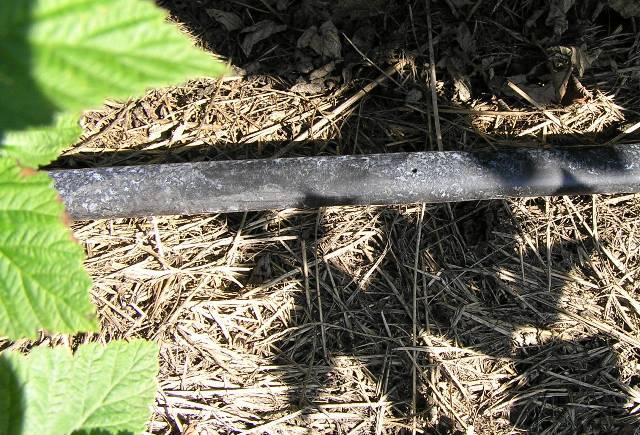
Irrigation for commercial raspberry production in Manitoba is essential. There are many types of irrigation systems available. However, trickle irrigation is the most effective and economical method. However, it does not provide for frost control or crop cooling but does have the benefit of reducing disease spread. The best time to irrigate is during establishment of the planting and at fruiting time. The greatest increase in berry weight occurs 7 to 10 days before it is ripe and is the time when adequate moisture levels are most critical. The soil should be soaked to a depth of 25cm. Lighter soils may absorb more than 50mm, while heavy soils require only 25mm at a time.
Pruning and Renovation
Pruning
Pruning is an important consideration in raspberry production because it helps to maintain a desired row width, limit cane density, tip or remove the top portion of the cane, remove spent fruiting canes, and remove weak, damaged, and diseased canes. Plants which do not receive proper pruning will have a considerably lower useful life expectancy. The pruning process should start in the first 3-4 years and continue on a yearly basis (more frequently if required by disease outbreak or plant damage) and become more substantive as the crop matures at 6-10 years.
Renovation
Renovation is the process of mowing and narrowing rows after harvest to remove diseased or insect damaged plants, provide space and accessibility for harvest, and stimulate renewed growth. Avoid renovating plantings in the establishment year.
Harvesting
When to Harvest
Raspberries are generally ready for harvest in July or August. The fruit is considered ready for harvest when ripe because no further ripening occurs after the berry is picked. The decision to harvest also depends on the end-use of the fruit. For fresh markets the grower should harvest the fruit at the beginning of the harvest season. For processing the fruit should be harvested at the end of the season. The typical harvest interval is generally four weeks. The fruit should be picked two or three times a week during its peak every day during hot dry weather.
U-Pick
Raspberry harvesting at present is primarily done as a U-Pick operation with some growers offering pre-picked berries. This method can be time consuming for the grower, may become market saturated and presents difficulties with consistency of product ripeness, operational size and facility layout, legal implication and local market conditions. However, this method eliminates the need for harvesting, picking staff, containers, handling and grading facilities, and storing or shipping equipment.
Mechanical Harvest
Mechanized harvesting is carried out when the raspberries are utilized for processing or freezing. These harvesters are generally very expensive due to their uniqueness and limited availability. The use of mechanical harvesters is therefore restricted to operations of 5 acres or more due to the economies of scale and the high investment in equipment. Control of insects and diseases are major problems associated with mechanically harvested fruit. At present, very few mechanical harvesters are used on the Prairies.

